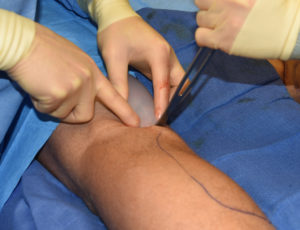Calf augmentation is one of the most infrequently performed of all body contouring procedures. Part of the reason for its low rate of performance is patient demand. The other reason is that most plastic surgeons are uncomfortable performing the procedure having never seen it done or been trained to do it.
The widespread use of fat grafting has increased the number of calf augmentation being performed. This is a much simpler method that requires no surgical method and avoids the use of an implant. But is far from reliable in creating assured volume and in many calf augmentation patients is not an option due to lack of adequate fat donor sites or tight calf tissues.
In the March 2017 issue of the journal Plastic and Reconstructive Surgery an article was published entitled ‘Safety and Efficacy of Subfascial Calf Augmentation’. In this paper the authors review their 12 year experience with 134 cases of either primary or revisional calf implant surgery. In all primary cases they performed a subfascial implant placement technique. In revisional cases injectable fat grafting and/or implant repositioning was done. The authors conclude that the placement of calf implants is a safe and easy procedure to perform, has a rapid recovery period and a low complication rate. (< 1%)
Of the three possible calf implant tissue locations (subcutaneous, subfascial and intramuscular, the subfascial is the best. While originally described in its introduction back in the late 1970s as an intramuscular technique, the risk of nerve injury and the induced muscle trauma favors a more superficial location. While a subcutaneous pocket dissection is very easy it is prone to visible encapsulation and implant show. The subfascial location offers good implant coverage, a lower risk on capsular contracture and a more natural appearance.
While subfascial calf implant placement is preferred, there are several important technical maneuvers to have an uncomplicated outcome. The incisional access must be in a popliteal skin crease and be fairly small in length. Once past the incision the actual fascia covering the calf muscles is lower than one would initially think. The fascia immediately beneath the incision is that of the hamstring tendons. On the inner knee these are the semimembranous and semitendinous tendons. On the outer knee it is the biceps femoris tendons. One must go past these tendons and look lower for calf muscle fascia.
The subfascial dissection should be carried out with a flat broad instrument that is long enough to reach calf muscle-soleus junction which is located at the midway point between the knee and the ankle. Here the fascia becomes adherent and the implant can not extend below this level. If the fascia is inadvertently perforated here and the implant is placed in a combined subfascial/subcutaneous location it will cause persistent postoperative discomfort.

Dr. Barry Eppley
Indianapolis, Indian



